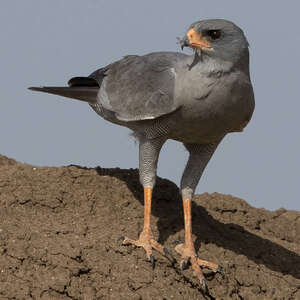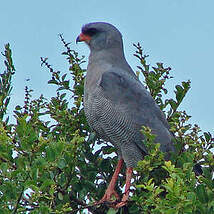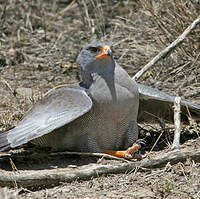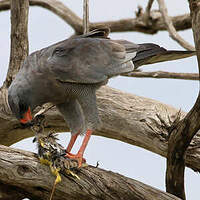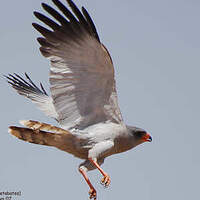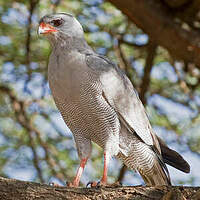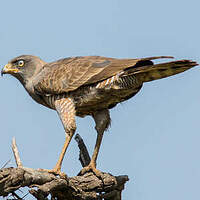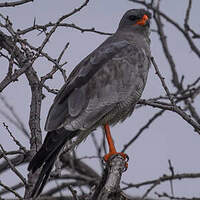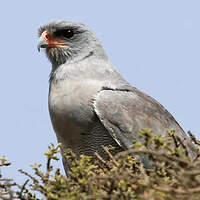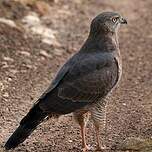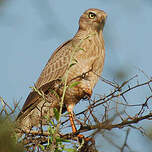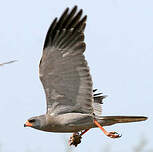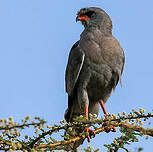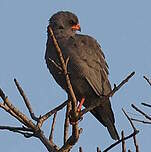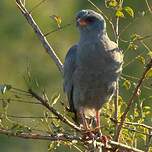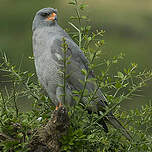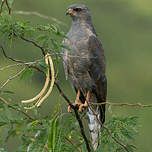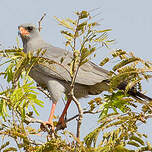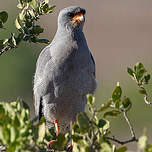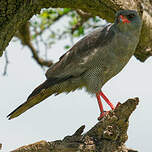Dark Chanting Goshawk
Melierax metabates - Autour sombre
Identification
The Dark Chanting Goshawk is a slim and robust diurnal raptor, with wide, rounded wings at the tips, a long cuneiform tail and long legs. In terms of size, it is in the high average of Accipitrids. The female is larger than the male, as is generally the case with raptors. The upper parts of the adult are gray, bluish under the blue sky, with brown mottles on some feathers in sub-adults. The tail is black above and whitish barred underneath. The underside is finely barred in gray and white in small waves. Only the chin, throat and chest remain unified. The remiges are dark gray, clearly visible in flight and the underside of the wings is whitish gray. The contour of the eye is dark and the superciliary arch is very marked. The wax and tarsi are pink-orange. The tip of the bent and black beak is used to tear, skin and tear. The iris is dark brown. The gray color is absent in the young bird. It gradually appears in the immature. The juvenile plumage is generally oatmeal brown, edged with beige on the top. There is white at the base of the tail. The head, neck and chest have pale streaks. The flanks, belly, under-tail, trousers and under-wings are pale, clearly barred with warm brown, with finer bars on the trousers. The remiges and rectrices are light and clearly barred, finely for the wings, coarsely for the tail. The tarsi are orange-pink, the wax gray and the iris is yellow. At this stage, young ones can be confused with young Grey-winged Buzzards.
Subspecific information 4 subspecies
- Melierax metabates metabates (Senegal to Ethiopia and n Tanzania)
- Melierax metabates theresae (sw Morocco)
- Melierax metabates ignoscens (sw Arabian Pen.)
- Melierax metabates mechowi (Gabon to s Tanzania south to Angola and ne South Africa)
Foreign names
- Autour sombre,
- Azor lagartijero oscuro,
- açor-cantor-escuro,
- Graubürzel-Singhabicht,
- piroslábú éneklőhéja,
- Donkere Zanghavik,
- Astore cantante scuro,
- mörk sånghök,
- Mørksanghauk,
- jastrabec pláštikový,
- jestřáb volavý,
- Mørk Sanghøg,
- lauluhaukka,
- Donkersingvalk,
- astor cantaire bec-roig,
- Sönghaukur,
- jastrzębiak ciemny,
- tumšais dziedātājvanags,
- golobičar,
- Тёмный певчий ястреб,
- ウタオオタカ,
- 暗色歌鹰,
- mörk sånghök,
- 暗灰紅臉歌鷹,
Voice song and call
The Dark Chanting Goshawk is not a vocal bird. It is usually silent outside the breeding season. It is the only time a loud, rather melodious cry can be heard, sometimes for long hours. A phrase is repeated at regular intervals, wheee-wow.... wheee-wow... This is the most common vocalization, mainly heard early in the morning and at dusk. Another shorter three-note phrase klee-klee-klee or klee-klee-klew resembling the cuckoo can generally be repeated in long series, which appears to be an alarm call used in situations of threats and danger. During the feeding period of the young, a male with prey call will attract the female.
Habitat
The Dark Chanting Goshawk lives and reproduces in a wide variety of forest habitats including moist deciduous forests but not excessively, old olive groves, palm groves, orange groves and thorny bushes including well-wooded savannas. It usually avoids overly dry habitats occupied by other species of the genus.
Behaviour character trait
The Dark Chanting Goshawk is a generalist and opportunistic hunter. From a fairly high perch, it watches for its prey to attack towards the ground.
Bushfires are a good way for it to hunt all small fleeing animals. In the same way, it can feed itself by occasionally following bucorvids that disturb small prey during their terrestrial movements. Finally, and more rarely, it can hunt by fast flying in closed environments such as woods and forests. The species is typically sedentary in most regions. It is usually silent, but when the breeding season arrives, the male emits a chanting call at regular intervals for sometimes hours. Throughout the breeding cycle, the couple calls, together or separately, from a perch or in flight during aerial parades. During the feeding of the young, the male communicates to the female with a special call to indicate that he has captured prey.Dietfeeding habits
The Dark Chanting Goshawk is an opportunist and feeds on a wide range of prey. Its diet mainly consists of small vertebrates: lizards, snakes, rodents, frogs and birds whose size can approach that of guineafowl, francolins or hornbills. Regarding mammals, it focuses on small animals up to the size of mongooses. Insects are also part of its diet: beetles, crickets, grasshoppers... On occasion, it can be a scavenger.
Reproduction nesting
The breeding of the Dark Chanting Goshawk extends from February to November throughout its range. On the northern, western and eastern part it breeds from February to July, from August to November in Southern Africa.
The species is monogamous. Before nesting, the Dark Chanting Goshawk emits a 'chant' from the tops of trees, then it is time for the courtship displays by the pair, accompanied by many calls. The pair's territory is in a dense forest where the two adults build a platform of branches usually placed in a fork at a low height - between 4 and 9 meters, rarely beyond that. The nest is lined with mud, grass and dry debris. Old songbird nests are sometimes also used and then covered with spider webs. A previous year's nest can be reused and the territory can remain the same for several years in a row. The female lays 1 or 2 whitish-bluish eggs with a three day interval but generally only one chick survives. Incubation is done by the female only for at least 30 days. The young is flying at the age of 40-50 days.Geographic range
The Dark Chanting Goshawk is widely distributed and common throughout Sub-Saharan Africa with recent data from the Congo-Brazzaville. Isolated populations are known in the southwestern Arabian Peninsula and in southwestern Morocco (Souss and Anti-Atlas foothills). Vagrants, potentially immatures, have been noted in the Iberian Peninsula. Its altitudinal range can go up to 1900 meters in Arabia and to 3000 meters in the heart of Africa. The species is not migratory but movements towards the south may occur in case of extended dry periods. Nonetheless, it stays absent from the driest and wettest areas within its extended range.
Threats - protection
IUCN conservation status
concern
in the Wild
threatened
evaluated
The Dark Chanting Goshawk is not threatened globally at present, but remains vulnerable in some areas due to deforestation and overgrazing by herds in arid areas. It is in critical danger of extinction and likely near extinction in Morocco.
Sources of information
- IOC World Bird List (v15.1), Gill, F and D Donsker (Eds). 2025-12-07.
- Birds of East Africa: Kenya, Tanzania, Uganda, Rwanda, Burundi, Terry Stevenson, John Fanshawe
- Birds of the World, The Cornell Lab of Ornithology
- eBird, Cornell Lab of Ornithology et National Audubon Society
Other sources of interest
 Specification sheet created on
18/07/2023 by Nathalie Santa Maria
Specification sheet created on
18/07/2023 by Nathalie Santa MariaTranslation by AI Oiseaux.net
© 1996-2025 Oiseaux.net
- Accipitriformes
- Aegotheliformes
- Anseriformes
- Apodiformes
- Apterygiformes
- Bucerotiformes
- Caprimulgiformes
- Cariamiformes
- Casuariiformes
- Charadriiformes
- Ciconiiformes
- Coliiformes
- Columbiformes
- Coraciiformes
- Cuculiformes
- Eurypygiformes
- Falconiformes
- Galliformes
- Gaviiformes
- Gruiformes
- Leptosomiformes
- Mesitornithiformes
- Musophagiformes
- Nyctibiiformes
- Opisthocomiformes
- Otidiformes
- Passeriformes
- Pelecaniformes
- Phaethontiformes
- Phoenicopteriformes
- Piciformes
- Podargiformes
- Podicipediformes
- Procellariiformes
- Psittaciformes
- Pterocliformes
- Rheiformes
- Sphenisciformes
- Steatornithiformes
- Strigiformes
- Struthioniformes
- Suliformes
- Tinamiformes
- Trogoniformes




